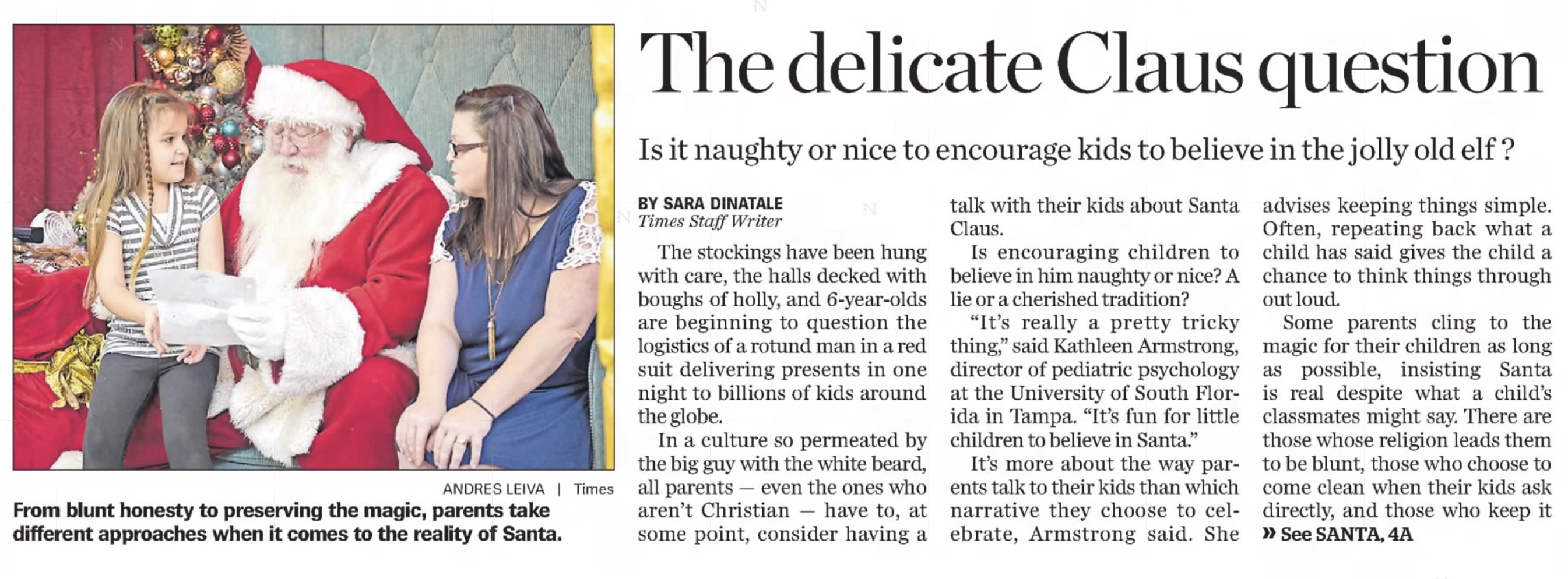A friendly holiday warning: The following story contains sensitive information about Santa Claus. Reader discretion is advised. A version of this story was originally published Dec. 18, 2020.
In November 2019, an email press release caught the attention of CD Davidson-Hiers. A sensory-friendly Santa Claus was coming to a local mall in Tallahassee, Florida.
“What Santas would not be sensory-friendly?” Davidson-Hiers, who covers K-12 education for the Tallahassee Democrat, asked herself. This Santa was trained to interact with children with special needs and take cues from caregivers, according to the press release. The reporter knew she wanted to cover it.
Davidson-Hiers wrote a brief about Kriss Kringle’s upcoming visit.
Because of time constraints, Davidson-Heirs said she could not interview the mall Santa. But if she had, he would have been Santa Claus, no matter who was under the beard.
“It never occurred to me to name the person, because that would be the biggest life spoiler, I would think, for kids,” she said.
Every holiday season, journalists covering Santa Claus face this delicate dance. There are parents who shield their children from the truth about the portly white-bearded man bearing gifts, and that same sensitivity spreads, for the most part, to newsrooms.
“This is a real challenge for journalists because you have two values that are competing against each other, and one is to tell the truth and the other is to minimize harm,” said Kelly McBride, Poynter senior vice president and chair of the Craig Newmark Center for Ethics and Leadership. “You can tell the truth about Santa, and you’re probably not going to accomplish a broader public good. So whenever you have two values conflicting with each other, you’re really trying to figure out how you balance that conflict while accomplishing a broader public good.” (Disclosure: McBride, who is also the NPR Public Editor, is my boss.)
McBride said the first thing journalists need to pay attention to is where their consumers will be. Her advice for those in a broadcast medium like television or radio, or who are creating content that’s going to be on social media or in a printed medium that might end up lying around the house: “You have to be very cognizant of the fact that you are in somebody’s home and they have already established a set of beliefs and norms around Santa, and you don’t want to interfere with that,” McBride said. “You tend to create devices that are the equivalent of a wink to the people who do know the broader truth about Santa, but don’t give away the truth to the people who are embracing a different version of the truth.”
Sara DiNatale, a reporter who covers retail, tourism and workplace culture for the Tampa Bay Times, received some backlash when she wrote about Santa four years ago. At the time she was a digital reporter and, while brainstorming holiday story ideas, wondered about how parents talk to their children about Santa Claus.
“This is something every parent has to deal with, even if they don’t celebrate Christmas, because it’s so pervasive in our culture,” DiNatale, who is not a parent, recalled thinking. “Why not take a measured approach to it and look at it from an overhead view?”
The story posed the question of whether encouraging children to believe in Saint Nick is naughty or nice. “A lie or a cherished tradition?” the story read, in part. DiNatale cited a director of pediatric psychology in the story and spoke to parents.

Tampa Bay Times reporter Sara DiNatale’s story sparked some backlash. (Courtesy: Tampa Bay Times)
DiNatale said she expected some readers to be annoyed by her story. “As a newspaper reporter, you get used to negative comments even when you write the most positive stories,” she said. “I wasn’t totally shocked, but some of the emails I got took it to a level I definitely wasn’t anticipating.” Someone even named her and the Times in a Reddit post, accusing them of crusading against Christian beliefs.
The story was placed on the front page, but DiNatale said the staff was very careful with the headline in print. “It wasn’t like ‘Santa; Not Real’ or something crazy,” she said, adding that she never got an email from a parent who said she’d ruined the secret of Santa Claus.
DiNatale wrote more Santa stories this year, but they didn’t receive such strong feedback. From that experience, she learned that this is one of those subjects in which its impossible to please everyone. DiNatale said she also got many positive emails from parents who appreciated the thoughtful approach.
In 2007, Mike Gordon dressed in a fuzzy red suit and fake white beard to play the role of Santa at a mall. His editor at The Honolulu Advertiser, where Gordon was a features writer/columnist at the time, thought it would make for a great story. It would be Gordon’s second time playing Santa — he did it once before, in 1988.
What resulted was a humorous and heartfelt first-person take about being a mall Santa.
“The first child looked up from her stroller, brown eyes growing wide, and promptly began to cry,” Gordon wrote. “Ho, ho, ho, no. The ‘Merry Christmas’ caught in my throat. Then she began to howl. Not a very good start, Santa.”
It’s a tough job, being Saint Nick. Gordon described feeling like a sheepdog with reading glasses under his Santa wig. In the story, the then-features writer wrote the sole mission when you put on a Santa suit is to make others smile.
“I described myself, when I talked about it and when I wrote about it, as a mall Santa. I kind of glossed over the aspect of ‘OK, am I the Santa? There are more Santas?’” said Gordon, who is now a night city editor at the Bend Bulletin in Bend, Oregon. “I described myself and others who were there as mall Santas. That was our job.”
It did cross Gordon’s mind that a child may read the story, which is why he tried to make the distinction of a mall Santa clear.
“I do remember thinking, ‘Well, I hope somebody who reads it doesn’t put two and two together here and figure out that there’s something going on here that’s not quite right,’” he said. “We’re all dancing around at the bit here. Santa’s the icon of Christmas and he brings joy to everybody. You don’t want to hamper with that. You don’t want to be the one who is always remembered as bursting the bubble for a child.”
In the piece, Gordon wrote that he consulted a “true master,” a man who spent three decades as a mall Santa. “I wondered how that would look in a picture, if we posed for a picture together,” he said. “I just said he’s a mall Santa. He talks to children. I probably thought that a lot of kids weren’t going to read the features section, either. I might’ve been banking on that.”
Callie Crossley, a radio, TV host and commentator for GBH News in Boston, advised journalists to cover Santa with a light hand.
“I think if you’re going to do the live one, you do really want to be careful because kids are very vulnerable. Why destroy something if you don’t have to? You can write around that,” Crossley said.
At work, Crossley is known for her extensive collection of Black Santas. It’s a source of joy for the veteran journalist, who began decorating her office with them several years ago. “No two of my Black Santas are alike — ranging from tall, squat, skinny and jolly belly round with distinctive African American features and skin tones from café au lait to deepest chocolate,” the veteran journalist said in a commentary earlier this week. Because of the coronavirus pandemic, Crossley has had to postpone her Black Santa display until next year.

Callie Crossley, a radio, TV host and commentator for GBH News in Boston, in her office with her black Santa collection, in December 2018. (Courtesy: GBH News)
In 2016, she brought up the controversy around the Mall of America’s first African American Santa, and this year she mentioned the viral story of a Black couple in Arkansas who received a nasty note in their mailbox about the inflatable Black Santa in their yard.
“I think, early on, that was one of the reasons I wanted to write about it and address it,” she said. “One of the commentaries goes right at it: Representation matters, even if it’s a fun, fictional character as I write because people can see themselves.”
For Gordon, being Santa was fun.
“When you dress up as Santa, people look at you differently. When you walk through the mall as Santa and you say hello at people, they smile,” he said. “You can ask them any question you want. ‘Have you been good this year? Oh, you haven’t? Oh, OK.’ You’re not you. When you put on this suit and you walk through the mall, you bring — or have the power to bring — a certain amount of joy to people… now you’re a big old guy in a red suit with a beard and you stand out. People know who you are. They know what you represent, and they smile. And that’s good. We need more smiles.”
Quick tips for covering Santa
You better watch out. You better not cry. Better not pout. I’m telling you why. Because we have some tips for you, courtesy of McBride, on covering Santa as a journalist:
- Do not give the myth away. “You don’t say it’s not true,” she said. “You don’t blunder into it by forgetting that a portion of the population believes in this myth.”
- Be very careful with the language you use, to not give it away. Choose your words very carefully.
- If you name someone who is playing Santa, there should be a good journalistic reason for doing that.






